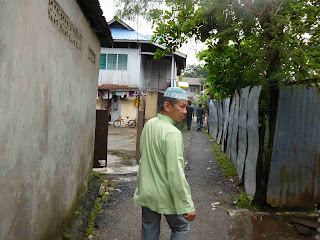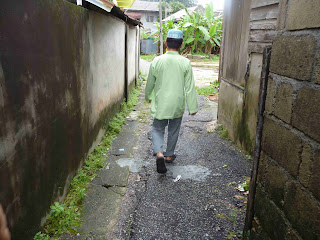We couldn't locate Lorong Minyak Gas (literally kerosone street) in the vicinity of Lorong Gajah Mati. This road was named after a shop that sold kerosene for use in kerosene stoves for cooking purposes. Long long ago, Malay homes used either charcoal or kerosene stoves. Many homes chose kerosene stoves over charcoal stoves. My home in Malacca used a big homemade charcoal stove while my Malacca aunt used a commercial kerosene stove.
We stopped at an old squatting WC (jamban cangkung) that was roughly 2 feet above ground. I took a close look at the interior - I didn't like the sight of it. We were starring at the masterpiece when a lady called from behind us. I turned to look at her - she had false front teeth. She asked us what we were doing in the area. Affandi asked her for the direction to Lorong Minyak Gas. She said we were in the wrong place and to go back to where we came from the main road, and to go the opposite direction.
We headed back to the main road (Lorong Gajah Mati). There we met with an elderly lady named Nab (could be short for Zainab). She asked who we were and Affandi explained we were looking for Lorong Minyak Gas. Affandi described who he was - son of Yah, daughter of Esah, Yah sister of Nik Kob. It is rather strange that in the Kelantanese language, names are usually simplified to a single syllable and relationships are remembered. Nab knows Yah and they were friends, they are possibly of the same age. Nab appeared very happy talking to us. He asked Affandi where he worked and Affandi replied at USM. Nab interrupted and asked, "Doktor ke"? Nab said Yah had mentioned one of her children is a doctor! OMG! Nab turned to me and asked what I do. Affandi replied I teach, which is correct. We didn't bother to specify what our occupations are in order to keep the conversation lively and not to surprise Nab. Then it was time to go. I don't have a photo of Nab as my camera ran out of battery. Will try to bring Yah to see Nab next time, insyaAllah.
Wednesday, 26 December 2012
Malay House
While Affandi was talking to some villagers of Lorong Gajah Mati, I searched the area. I came across an interesting building. I went back to asked the villagers about the building. A boy said that it was the house of Wae Deng (Wan Din) who was a skilled house builder. I asked the boy where was he. The boy replied he died long ago. The house seemed vacant. I took some shots to show you what a Malay house looks like on the exterior. I can't tell which was the front and back. You decide.
External links:
http://archnet.org/library/
Hijjas bin Kasturi
http://archnet.org/library/
Hijjas bin Kasturi
Lorong Gajah Mati
The sultan's office in Kota Bharu is at Istana Balai Besar, and was once surrounded by big bamboo poles. Once is a while these bamboo poles would make a bursting sound in the dry season. Thus, the area is called Pintu Pong and the road named Jalan Pintu Pong.
Istana Balai Besar is not far from a Malay village which is sited at Jalan Gajah Mati. We asked the villagers (2 boys and an elderly lady in her late 70s) why the place was named Jalan Gajah Mati. One boy said a white elephant that had 6 legs died in the village long ago. The lady informed us nobody remembers the story of the white elephant that had died here and the village named after it.
From my reading, a white baby elephant had escaped from the palace and the villagers gave chase to recapture it. It ran in the direction of a Malay village by Sg Kelantan. However, the villagers' huts huddled close together and there was only a narrow path in that village. This baby elephant ran and entered this narrow path. Because it could not pass through the narrow path it got stuck and then died at this village. The lane was thus name Lorong Gajah Mati after the white royal elephant that died while trying to escape. Whatever the true story of how this village derived its name, nobody remembers anymore.
We went to look at the house where Affandi grew up and where we met his mother, 17 years after mother and son were separated. It took us a month to search for his mother's location. We knocked on every door and asked everyone we met on the way to the old house. We found her! It was a tearful meeting after that long.
Map of Jalan Gajah Mati and nearby areas
http://goo.gl/maps/47GTL
Istana Balai Besar is not far from a Malay village which is sited at Jalan Gajah Mati. We asked the villagers (2 boys and an elderly lady in her late 70s) why the place was named Jalan Gajah Mati. One boy said a white elephant that had 6 legs died in the village long ago. The lady informed us nobody remembers the story of the white elephant that had died here and the village named after it.
From my reading, a white baby elephant had escaped from the palace and the villagers gave chase to recapture it. It ran in the direction of a Malay village by Sg Kelantan. However, the villagers' huts huddled close together and there was only a narrow path in that village. This baby elephant ran and entered this narrow path. Because it could not pass through the narrow path it got stuck and then died at this village. The lane was thus name Lorong Gajah Mati after the white royal elephant that died while trying to escape. Whatever the true story of how this village derived its name, nobody remembers anymore.
We went to look at the house where Affandi grew up and where we met his mother, 17 years after mother and son were separated. It took us a month to search for his mother's location. We knocked on every door and asked everyone we met on the way to the old house. We found her! It was a tearful meeting after that long.
Map of Jalan Gajah Mati and nearby areas
http://goo.gl/maps/47GTL
 |
| Path to Affandi's old rented house by Sg Kelantan |
 |
| Affandi's feels happy to be back in his village |
Masjid To' Mesir
We visited an old mosque in Kota Bharu. This is Masjid To' Mesir. We don't know about the background of To' Mesir. The mosque was recently renovated in 2010. A narrow broken bitumen path leads to the mosque from Jalan Gajah Mati entrance. Corrugated zinc sheets were used as fence by the villagers for privacy. They can be a problem as some parts of the zinc fences were rusty and jutting out. There were no fences when we visited the area in the early 1980s. It was a madrasah (Kelantan malasoh) from 1963 to 2009. Its status was upgraded to masjid on 31 January 2010.
 |
| Lorong Gajah Mati entrance in Kota Bharu |
 |
| Affandi showing the way to the mosque which lies in his village |
 |
| Masjid To' Mesir |
 |
| Renovation plaque |
Banjir 2012
It is the monsoon season now. It rained for a week and stopped today on 25 December 2012. My husband and I went about to see the flooded areas in Pasir Tumboh, Kg Mentuan, Binjai and Kota Bharu.
In Pasir Tumboh, the area by the bridge was flooded and villagers used boats to get around. This year the boats were better and looked stronger. There were only a few cars parked by the roadside, indicating the outsiders (working children of the villagers) have long left the area.
In Kg Mentuan, water filled the low lying areas (possibly old abandoned paddy fields). We went to see my husband's brother's house in the area. The flood water had subsided but there was still a large patch of water-logged area of the road that led to his house which is sited in a clearing at the edge of the forest.
In Binjai, the huts for the daily market by the main road were all submerged. A few kids could be seen playing in the water. There was a bunch of kids playing water football. Domesticated animals (cows) were up on the verge.
In Kota Bharu, the roads were clean after the heavy rain. Traffic jams formed in all roads and at all intersections. People went about on foot to obtain food. Sg Kelantan swelled to almost maximum but did not flood Kota Bharu. The roads were not flooded. High concrete embankment slabs lined the entire water's edge. Residents said they could not view the river anymore. The rainwater that was trapped between the concrete slabs and land appeared much like air teh tarik (I use this analogy for lipaemia for my class lectures). I saw a well at the water's edge.
Banjir December 2012/January 2013 was rather queer. It rained heavily beginning 15 December 2012 for 3 weeks till 3 January 2013. Then it didn't rain on Friday, 4 January 2013 for 4 days. The sun shone bright for 4 days and all the flood water dried up. Even the flood water next to Pasir Tumboh bridge dried up except for a few areas where the flood water could still be seen and muddy tracks led to the wooden houses on stilts. Heat was intense and I suffered a headache after walking in the hot weather. Then it rained for a second time on 9 January 2013 but with weaker force. It only rained for a brief while in the afternoon when the schoolchildren had completed school. The children walked home in the light rain, not carrying any umbrella. They probably thought the rain was gone for good and were caught unprepared and without umbrellas.
In Pasir Tumboh, the area by the bridge was flooded and villagers used boats to get around. This year the boats were better and looked stronger. There were only a few cars parked by the roadside, indicating the outsiders (working children of the villagers) have long left the area.
In Kg Mentuan, water filled the low lying areas (possibly old abandoned paddy fields). We went to see my husband's brother's house in the area. The flood water had subsided but there was still a large patch of water-logged area of the road that led to his house which is sited in a clearing at the edge of the forest.
In Binjai, the huts for the daily market by the main road were all submerged. A few kids could be seen playing in the water. There was a bunch of kids playing water football. Domesticated animals (cows) were up on the verge.
In Kota Bharu, the roads were clean after the heavy rain. Traffic jams formed in all roads and at all intersections. People went about on foot to obtain food. Sg Kelantan swelled to almost maximum but did not flood Kota Bharu. The roads were not flooded. High concrete embankment slabs lined the entire water's edge. Residents said they could not view the river anymore. The rainwater that was trapped between the concrete slabs and land appeared much like air teh tarik (I use this analogy for lipaemia for my class lectures). I saw a well at the water's edge.
 |
| Pasir Tumboh |
 |
| Binjai |
Subscribe to:
Comments (Atom)






















